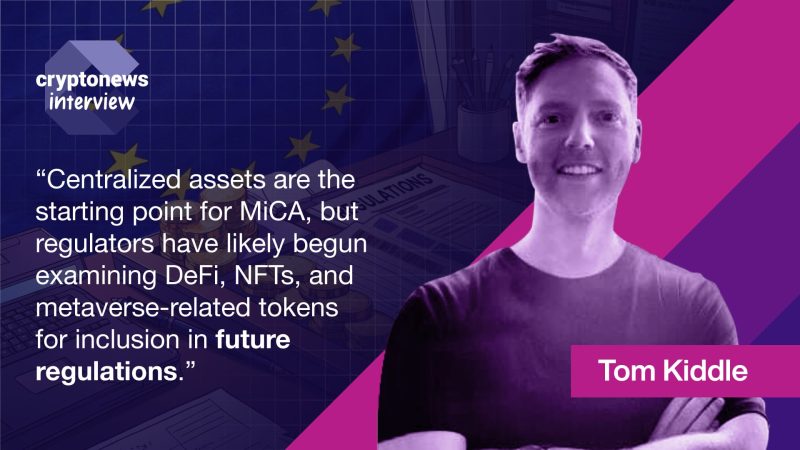How can crypto be without regulators? That is a question a lot of crypto enthusiasts would want an answer to. Is MiCA in our favor? Probably.
But here is the reality: regulatory clarity has become one of the most sought-after elements for businesses looking to establish a strong foothold in the market.
With numerous regulatory frameworks in place around the world, the European Union’s Markets in Crypto Assets (MiCA) regulation stands out as a leading example.
It is renowned for providing businesses with much-needed transparency and guidelines, MiCA proudly represents the EU’s ambition to become a global leader in the crypto space.
Last week, Tom Kiddle, the co-founder of Palisade, a digital asset custodian backed by Ripple, shared some of his insights from the Digital Commonwealth’s Mansion House Summit with Cryptonews.
His views spanned the challenges and opportunities presented by MiCA and how the changing global political landscape is reshaping crypto regulation.
Having worked across notable companies like Ripple, Apple, and BT, Kiddle’s understanding of regulatory frameworks, consumer protection, and governance gives him a unique perspective on the hurdles still facing the crypto sector.
While MiCA is being hailed for the clarity it brings to the market, Kiddle raised important concerns.
From the question of whether MiCA offers sufficient protection for retail investors, to the gap in regulation for NFTs and decentralized finance (DeFi), Kiddle believes the regulation is a significant first step but far from comprehensive.
With geopolitical tensions rising and cryptocurrency being scrutinized as a tool for money laundering, global regulatory cooperation will be essential for the future of crypto assets.
The EU’s MiCA laws may provide a competitive advantage, but the global regulatory environment is still tightly fragmented.
This comprehensive story explores Kiddle’s insights on the key issues surrounding MiCA, its potential evolution, and the implications for global cryptocurrency regulation. Let’s get straight in.
MiCA Crypto Regulations: Is Consumer Protection in Focus?
The EU’s MiCA regulation is a major achievement and a massive step forward in creating a unified framework for the cryptocurrency sector.
As Kiddle pointed out during his presentation, the primary objective of MiCA is consumer protection.
With the cryptocurrency market’s inherent volatility and the growing number of retail investors participating, regulators have identified the need to safeguard consumers from unforeseen risks.
MiCA’s provisions, which ensure customer safety, align with the principles that any legitimate financial institution would be expected to uphold.
According to Kiddle, one of MiCA’s most significant achievements is the way it integrates traditional financial governance into the crypto world.
Kiddle explained, saying:
“MiCA is essentially about applying the standards expected of banks to the crypto world.”
The regulation strictly upholds the law that firms offering crypto services must maintain strong governance and risk management frameworks — principles that have long been a part of the traditional banking sector.
Governance in the world of fiat currencies ensures that firms make decisions in the best interest of their customers, and MiCA seeks to extend this to crypto.
This includes everything from financial risk management to maintaining robust IT infrastructure to reduce vulnerability to cyber-attacks.
“One could argue that both fiat and crypto assets function as money, and although not everyone shares this view, it raises the question: why shouldn’t crypto be afforded the same protections?”
While MiCA provides a strong foundation for protecting consumers, Kiddle was quick to note that it also respects the nuances of different crypto assets.
Not all crypto assets are treated the same under MiCA, as the regulation takes a risk-based approach.
For example, stablecoins and asset-referenced tokens (ARTs) face stricter oversight due to their potential for financial instability, while utility tokens and certain non-fungible tokens (NFTs) are subject to lighter regulation.
In fact, major exchange Bitstamp announced it will delist Tether’s euro-pegged stablecoin, Euro Tether (EURT), because it does not meet MiCA’s required standard.
Regulatory Gaps: The NFT and DeFi Dilemma
Despite MiCA’s positive strides, Kiddle also raised concerns about areas of regulation that remain vague or underdeveloped, particularly regarding DeFi and NFTs.
While MiCA provides clear definitions for different asset types like cryptocurrencies, utility tokens, and ARTs, Kiddle noted that NFTs and DeFi remain somewhat on the fringes of the current regulatory framework.
This, he believes, could pose challenges down the line as these markets continue to grow.
Kiddle elaborated on this point, stating,
“Although truly unique and non-fungible NFTs are excluded from regulation, there are potential grey areas where certain token types might not fit neatly within existing categories.”
NFTs, for example, could straddle the line between utility tokens and security tokens, making it difficult to regulate them uniformly. Additionally, the explosion of DeFi has introduced new complexities that regulators are still grappling with.
Kiddle said, emphasizing that the decentralized nature of these platforms makes it difficult to impose traditional compliance measures.
“DeFi remains much harder to regulate effectively.”
The lack of regulatory clarity surrounding DeFi could potentially create a risky environment for investors, who may not fully understand the mechanisms driving these decentralized platforms.
According to Kiddle, a stronger focus on consumer education will be necessary to help retail investors navigate these markets safely.
“Since many tokens are assets or securities, the average retail investor may still struggle to fully understand the risks, even with mandated whitepapers.”
Kiddle stressed that MiCA’s success hinges not only on its enforcement but also on the quality of the disclosures that accompany it.
For instance, vague or overly technical whitepapers could hinder investors from making informed decisions.
Therefore, improving the quality and clarity of these documents is critical in ensuring that retail investors fully understand the risks they are taking.
The Changing Political Landscape and MiCA II
The changing political landscape in Europe is expected to play a crucial role in shaping a potential MiCA II.
While crypto-assets are not currently at the forefront of most political debates, Kiddle believes the success or failure of MiCA could determine whether a second iteration of the regulation is needed.
“Centralized assets are the starting point for MiCA, but regulators have likely begun examining DeFi, NFTs, and metaverse-related tokens for inclusion in future regulations.”
Emerging technologies such as DeFi and NFTs pose significant regulatory challenges, particularly due to their decentralized nature and unique structures.
This complexity means that a broader, more comprehensive regulatory framework may be required to cover these new asset classes effectively.
However, Kiddle emphasized that the political climate could also influence how quickly and aggressively these regulations are developed.
Geopolitical tensions, particularly between East and West, could prompt regulators to scrutinize less-regulated assets over money laundering and sanctions evasion concerns.
“With rising geopolitical tensions, less-regulated assets could attract scrutiny due to concerns over money laundering and sanctions evasion,”
While the timeline for MiCA II remains uncertain, Kiddle speculated that it would likely include measures designed to enhance cross-jurisdictional cooperation, particularly with major jurisdictions like the United States and Asia.
Comparing the US and EU Regulatory Approaches: A Study in Contrast
One of the key topics Kiddle addressed during his speech was the contrasting regulatory approaches taken by the US and the EU.
While the EU has moved forward with a clear and comprehensive framework for digital assets, the US remains mired in regulatory uncertainty.
Kiddle expressed concerns about the US approach, which is primarily focused on regulation by enforcement rather than a proactive, rules-based system.
“The US has done little to advance a clear crypto regulatory framework. Instead, regulators and courts often decide the rules on-the-go,” Kiddle observed.
This lack of regulatory clarity in the US has driven many crypto businesses to seek more stable regulatory environments abroad, particularly in the EU.
MiCA offers companies a predictable roadmap for compliance, complete with licensing requirements, capital adequacy measures, and consumer protection guidelines.
In contrast, US crypto businesses face a fragmented regulatory environment, where rules can vary significantly from state to state.
One of the key advantages of MiCA, as Kiddle pointed out, is its creation of a single rulebook across all EU member states.
Once a business is licensed in one EU nation, it can offer services throughout the bloc, which would greatly help streamline operations and reduce the need for multiple licenses.
This provides a competitive advantage for the EU in attracting crypto businesses, especially custody providers who are seeking clear and consistent regulatory frameworks.
Kiddle argued that if the US wants to remain competitive in the global crypto market, it will need to develop a framework similar to MiCA, where regulations are clear, predictable, and uniform across states.
Only then, he argued, will the US be able to attract businesses and foster innovation in the digital assets space.
However, MiCA isn’t perfect. Kiddle notes that while it addresses many key areas, it lacks granular guidelines for emerging areas like DeFi and NFTs. This is significant because real-world asset (RWA) issuance and digital rights management (DRM) could greatly benefit from clearer regulatory structures.
The gaps in consumer protection and cybersecurity are also areas that will need to be addressed in future updates to the legislation.
The industry is closely watching MiCA 2.0, which is expected to provide further clarity on these issues. It has the potential to refine and expand the scope of the initial regulation.
While the US regulatory environment remains fragmented, the EU’s unified approach is seen as a major advantage for businesses.
The introduction of MiCA could serve as a model for other jurisdictions, particularly as more countries look to develop clear frameworks for the growing crypto industry.
Despite these advantages, MiCA is not without its challenges. The strict licensing requirements and ongoing reporting obligations could pose difficulties for smaller businesses, which may find compliance burdensome.
However, Kiddle acknowledges that these measures are essential for protecting consumers, even if they create additional hurdles for businesses.
The real challenge will be ensuring that MiCA keeps pace with the rapid evolution of technology, which tends to move faster than regulation.
About Tom Kiddle
Tom has a decade of experience spanning e-commerce, payments, and blockchain at notable companies like Ripple, Apple, and BT. He utilizes his rich background to contribute to the XRPL community by participating in developer residency workshops designed to enrich developers in the blockchain space and presenting seminars on the digital economy at universities.
Palisade, a French-regulated custodian, provides businesses with a comprehensive solution for managing digital assets securely. It offers features like wallet provisioning, compliance, multi-chain support, and operational freedom for businesses transitioning into DeFi and businesses operating within the web3 space.
The post “MiCA Regulation is Far From Complete” — Tom Kiddle, Ex-Ripple and Apple appeared first on Cryptonews.


